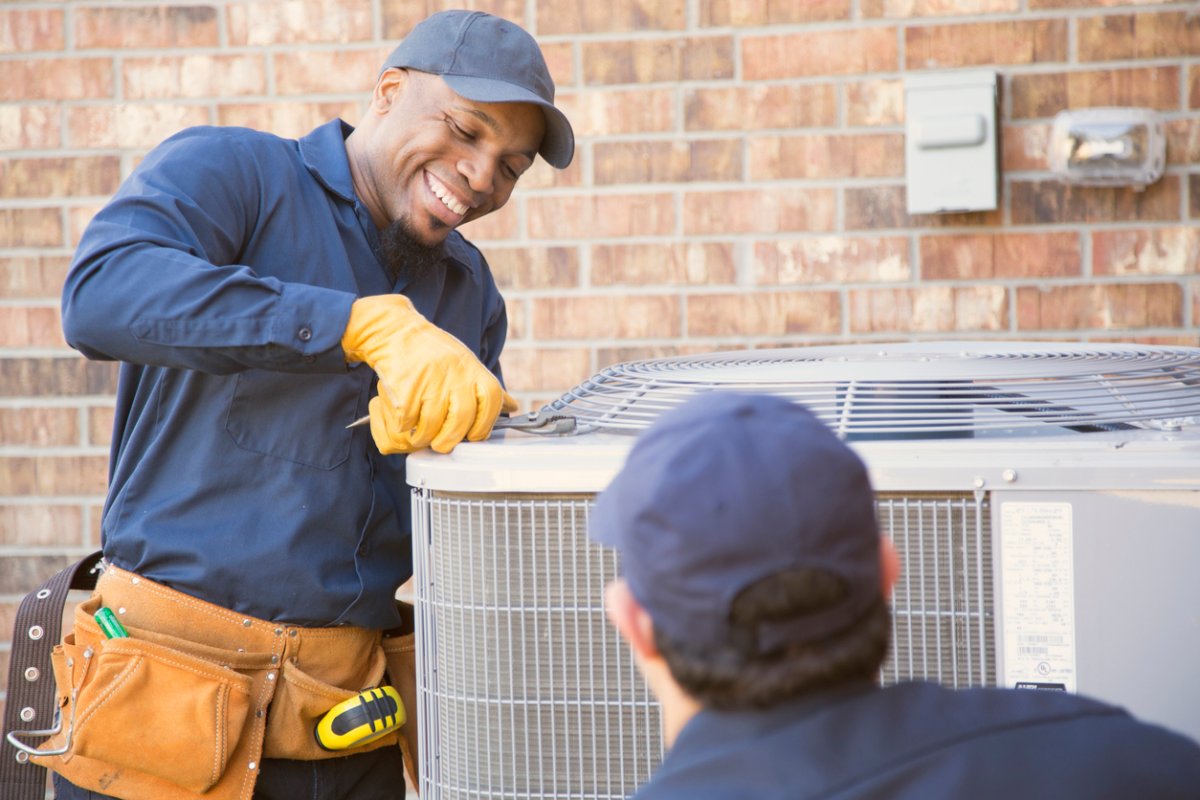

We may earn revenue from the products available on this page and participate in affiliate programs. Learn More ›
What You Need to Know
- There is a growing shortage of skilled laborers in the U.S. construction industry.
- Many high-school students are pushed toward a 4-year college degree rather than vocational school, which leads to fewer young people entering the skilled trades industry.
- The demand for single-family home construction is growing as the nation faces a housing deficit.
- There’s a false assumption that working in the trades is unfulfilling and low-paying; however, the opposite can be true.
Unlike many industries, the skilled trades aren’t greatly affected by the state of the economy. After all, if a homeowner has a leaky pipe, they need to call a plumber ASAP rather than hoping the problem resolves itself. Likewise, a homeowner with a busted AC unit on a 90-degree day isn’t going to want to deal with the issue for weeks—they’ll need an HVAC technician to come and fix it immediately. If a homeowner is feeling short on funds, it makes much more sense to cut back on going to restaurants or put off a new car purchase than it does to ignore a major home repair.
But the skilled trades industry in the U.S. doesn’t have enough workers to keep up with the growing demand. In addition to the steady demand for home repairs, single-family home construction is up, with the National Association of Home Builders estimating that the U.S. will need to build over 1.15 million single-family homes each year in order to reduce the country’s housing deficit. Those who opt to stay in their current homes will undoubtedly need repairs and updates as their houses age. But what if there aren’t enough pros to keep up with that demand?

The State of the Skilled Trades Industry Today
There’s always a demand for skilled labor workers, but that demand is growing. According to Associated Builders and Contractors (ABC), a national construction industry trade association representing more than 23,000 members, the construction industry will need to add approximately 501,000 jobs in 2024 to meet demand—and that’s in addition to standard hiring to replace employees who leave.
The U.S. Bureau of Labor Statistics estimates that the construction industry will have around 646,100 openings per year between 2022 and 2032. The specific occupations expected to have the biggest increase in demand are as follows.
|
Occupation |
Job Outlook, 2022 to 2032 |
Number of Additional Jobs, 2022 to 2032 |
|
Wind turbine technicians |
45% (Much faster than average) |
5,000 |
|
Solar photovoltaic installers |
22% (Much faster than average) |
6,600 |
|
Septic tank servicers and sewer pipe cleaners |
7% (Faster than average) |
2,200 |
|
Electricians |
6% (Faster than average) |
49,200 |
|
Heating, air conditioning, and refrigeration mechanics and installers |
6% (Faster than average) |
23,000 |
Given this projected growth, those entering the construction workforce can expect a steady flow of work and a livable wage. So why aren’t more people choosing this path?
“The biggest barriers I see are financial and also perception,” says Kyle Stumpenhorst, owner and founder of RR Buildings in Franklin Grove, Illinois. “[Historically], young people have…been told the big money jobs are not in the trades.”
Yet, the opposite is true. The median salary for plumbers is $61,550 per year, while an electrician salary is around $61,590 per year. Those who opt to start their own business in industries such as HVAC, construction, plumbing, residential cleaning, and tree maintenance can make over $1 million in annual revenue. Knowing all this, the question of why there aren’t enough skilled trade workers in the U.S. is even more mystifying.
Why is there a shortage of skilled labor in the U.S.?
It’s widely accepted that there are not enough skilled labor workers to meet current demands in the U.S. However, the reasons behind this phenomenon are debated, and they can likely be attributed to a variety of factors.
Residual Effects From the COVID-19 Pandemic
Labor shortages impacted almost every industry following the COVID-19 pandemic, including the skilled trades. According to the U.S. Chamber of Commerce, labor force participation is around 62.5 percent as of 2024, compared to 63.3 percent in February 2020. Across all industries, factors such as lack of childcare, early retirement, and improved unemployment benefits have meant that more employees are postponing their return to the workforce—or not returning at all.
Across the board, a preference for remote work following the pandemic has also impacted the workforce. The Chamber of Commerce survey showed that 49 percent of unemployed workers are only interested in considering roles that are remote. While there are more remote and hybrid positions than ever before in sectors such as finance, customer service, and software development, most skilled trade positions require workers to be on-site every day.
Workers Reaching Retirement Age
In general, previous generations were more likely to pursue jobs in the trades following high school than the current generation. This has resulted in the trades industry having an older workforce than many other fields. Around half of all trade workers are over the age of 50, which for many means retirement is not too far in the future. As more members of the current trade labor force retire, there are fewer and fewer entry-level recruits to replace them, resulting in an overall shrinkage of the workforce.
Another effect of older, experienced workers approaching retirement is that they are taking their knowledge with them. Young people who aspire to a career in the trades may have difficulty finding people to train and mentor them while they get their start.
Emphasis on Higher Education
Niki O’Brien, an operations manager at Custom Exteriors, LLC in Berthoud, Colorado, suspects a major reason for the shortage is a cultural emphasis on sending students to college immediately after high school. “When I graduated high school in 1995, substantially fewer of us were headed to college for many different reasons,” she explains. However, in recent decades, she perceives that more kids have been pushed to choose college, leaving fewer people choosing the trades for their careers.
A recent study from Jobber supports this. A full 79 percent of the college-aged members of Gen Z surveyed reported that their parents wanted them to attend a traditional university, with only 5 percent saying their parents wanted them to attend vocational school. Stumpenhorst can attest to this. “My generation was told to go to college and learn technology because that is where the money was. We were told that was the only way to be successful.”
However, while plumbing school costs an average of $3,000 per year, tuition at a public school for a 4-year degree runs about $9,700 per year. Therefore, students can expect a lot less debt if they choose a vocational school over a traditional 4-year college or university.
“Young people have…been told the big money jobs are not in the trades.”
– Kyle Stumpenhorst, owner and founder of RR Buildings
Stigma
Many Americans have preconceived notions that prevent them from pursuing (or encouraging their children to pursue) a job in the trades. According to Andrew Prchal, co-founder of Gunner Roofing in Stamford, Connecticut, “The industry itself isn’t looked at as the most glamorous. Most people probably think of trades and associate them with being dirty, when really there is a whole subset of people out there who would thrive in the kinds of hands-on, independent work that the trades industry provides.” Surveys confirm that 74 percent of college-aged students believe that there is a stigma associated with choosing to attend vocational school in lieu of a 4-year college.
There may be an additional perceived barrier for women who are interested in the industry but don’t think it is for them. According to O’Brien, “There is a stigma that construction is a men’s industry and [that] very few women enter the skilled trades. This couldn’t be further from the truth. I have seen women plumbers, electricians, painters, and more.”

The Future of the Skilled Trade Industry
Between 2022 and 2032, the Bureau of Labor statistics predicts faster-than-average growth for employment opportunities in some skilled trades. Those looking to enter the skilled trades may want to research the areas with the biggest projected growth when planning their career trajectory.
There’s also expected to be much faster than average growth for industries related to sustainability. For example, while the electrical trade is expected to grow 6 percent over the next decade, specialized electrical jobs in the renewable energy sector have a much faster projected growth. The demand for solar panel installers is expected to increase by 22 percent between 2022 and 2032, adding 6,600 jobs, while the demand for wind turbine technicians is expected to grow by 45 percent in that same period, adding 5,000 jobs. In other words, this may be a good time to enter these more niche fields while demand is increasing and the number of workers with these specific skill sets is relatively low.
Other skilled trades are likely to grow by 2032 as well. The demand for heating, air conditioning, and refrigeration (HVACR) mechanics and installers is projected to grow by 6 percent, with 23,000 jobs expected to be added by 2032. And the demand for septic tank servicers and sewer pipe cleaners is expected to increase by 7 percent in that time frame, with 2,200 jobs anticipated to be added.
So how are pros working in the skilled trades feeling about the demand in their industries? “I think it is going to get worse before it gets better,” says Prchal. “This is definitely a known thing in the industry, which is why manufacturers are constantly making products easier and easier to install.”
O’Brien has a more optimistic takeaway. “I think the future of construction looks bright,” she says. “[My husband] and I have already built and sold one successful roofing company. We are now building a roofing and exteriors company, which is growing at an even faster rate. Any young person entering the workforce now should consider a career in construction.”
Equally as important: Many are noticing a shift in attitude toward the trades. Stumpenhorst, who has a robust social media following, has seen this reflected in his interactions online. “I have been blown away by the optimism, passion, and willingness to lift the trades up by many amazing people involved. [Social media] has allowed people like myself to directly share our passion and love for what we do to others who otherwise might not have considered it as a career.”
Those who are graduating from high school or considering a career change will want to look into the skilled trades—even if they’re being pushed toward college. A career in the trades can provide job stability and self-sufficiency while paying a livable wage. And it’s clear that the demand for these jobs isn’t decreasing anytime soon.
